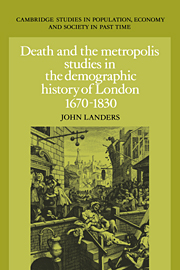Book contents
- Frontmatter
- Contents
- List of figures and maps
- List of tables
- Preface
- Acknowledgements
- Part I EIGHTEENTH-CENTURY LONDON AND ITS VITAL REGIME
- 1 Mortality theory and historical epidemiology
- 2 Aspects of metropolitan economic and social life
- 3 The ‘high potential’ model: a preliminary test
- Part II THE LEVEL OF MORTALITY
- Part III DIMENSIONS OF LONDON'S EPIDEMIOLOGICAL REGIME
- Appendices
- Bibliography
- Index
- Cambridge Studies in Population Economy and Society in Past Time
1 - Mortality theory and historical epidemiology
Published online by Cambridge University Press: 05 November 2011
- Frontmatter
- Contents
- List of figures and maps
- List of tables
- Preface
- Acknowledgements
- Part I EIGHTEENTH-CENTURY LONDON AND ITS VITAL REGIME
- 1 Mortality theory and historical epidemiology
- 2 Aspects of metropolitan economic and social life
- 3 The ‘high potential’ model: a preliminary test
- Part II THE LEVEL OF MORTALITY
- Part III DIMENSIONS OF LONDON'S EPIDEMIOLOGICAL REGIME
- Appendices
- Bibliography
- Index
- Cambridge Studies in Population Economy and Society in Past Time
Summary
The remarkable progress achieved in historical demography in the 1980s has been accomplished very largely at the price of excluding mortality from the domain of structural analysis. We contend, however, that such a price need not be paid, and that recent work has furnished the material for a structural understanding of mortality patterns in history. In the present chapter we shall try to justify this claim and thereby set out the frame of reference to be employed in the remainder of the volume. In order to do this we must first consider how mortality has been conceptualised as a variable in population history, from classical population theory onwards.
Classical theory
‘Classical’ population theory can be defined as the body of thought concerning population change and its determinants which first developed in Britain during the later eighteenth century, and acquired its greatest influence in the nineteenth. It was implicated, among other things, in the rise of Darwinian evolutionary theory and has persisted into the present century as an important strand in the ‘folk demography’ of the industrial west (Ardener 1974). The influence of the classical arguments has been felt primarily through the work of their most distinguished exponent, Thomas Robert Malthus, and such has been his celebrity – or notoriety – that the overall framework is itself often termed simply ‘Malthusian’.
This is an unfortunate label, however, for at least two reasons. In the first place it ‘over identifies’ with Malthus a set of assumptions common to his intellectual peers and which he himself advanced in a more flexible and pragmatic form than did some others (Wrigley 1987, 1989).
- Type
- Chapter
- Information
- Death and the MetropolisStudies in the Demographic History of London, 1670–1830, pp. 7 - 39Publisher: Cambridge University PressPrint publication year: 1993
- 1
- Cited by

